| Article ID | Journal | Published Year | Pages | File Type |
|---|---|---|---|---|
| 4970297 | Pattern Recognition Letters | 2017 | 8 Pages |
Abstract
Traditional approaches for object discovery assume that there are common characteristics among objects, and then attempt to extract features specific to objects in order to discriminate objects from background. However, the assumption “common features” may not hold, considering different variations between and within objects. Instead, we look at this problem from a different angle: if we can identify background regions, then the rest should belong to foreground. In this paper, we propose to model background to localize possible object regions. Our method is based on the observations: (1) background has limited categories, such as sky, tree, water, ground, etc., and can be easier to recognize, while there are millions of objects in our world with different shapes, colors and textures; (2) background is occluded because of foreground objects. Thus, we can localize objects based on voting from fore/background occlusion boundary. Our contribution lies: (1) we use graph-based image segmentation to yield high quality segments, which effectively leverages both flat segmentation and hierarchical segmentation approaches; (2) we model background to infer and rank object hypotheses. More specifically, we use background appearance and discriminative patches around fore/background boundary to build the background model. The experimental results show that our method can generate good quality object proposals and rank them where objects are covered highly within a small pool of proposed regions.
Related Topics
Physical Sciences and Engineering
Computer Science
Computer Vision and Pattern Recognition
Authors
Gang Chen, Haiying Zhang,
